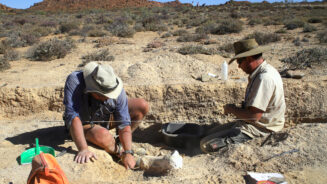A Window into the End of the Dinosaur Age
The northwestern regions of South Africa, along with the bordering countries of Namibia and Botswana, are dotted with crater lakes that offer a potentially rich—but, until now, largely overlooked—source of sediments and fossils from the Late Cretaceous Period, which began 145 million years ago and ended 66 million years ago.
Though scientists have developed a good understanding of the earlier years of the Dinosaur Age—especially the Jurassic Period, around 200 million years ago—their knowledge of the later Cretaceous Period in the Southern Hemisphere remains minimal, except for some areas of South America.
Thanks to the unusual geological conditions in the Northern Cape, the project to excavate the crater lakes offers a promising opportunity to “fill in the blank spaces on the map” of the Late Cretaceous Period—not only of the dinosaurs themselves but of the larger environment in which they thrived.
Who We’re Supporting
A gift from Griffin Catalyst will support a multipronged project directed by Dr. Peter Makovicky, a Professor of Earth and Environmental Sciences at the University of Minnesota, who previously spent 18 years as Chair of the Department of Geology at the Field Museum in Chicago. Makovicky has searched for fossil records on six of the world’s seven continents.
The support will enable the excavation of the newly discovered Kapkap dinosaur site, expanding excavations to several other crater lake sites nearby, and drilling into these crater lakes to establish their age and to search for evidence about the environments at the end of the Age of Dinosaurs in Africa.
The excavation will take advantage of a special feature of the region, known as kimberlite pipes—geological structures that scientists liken to long fingers of lava in the earth’s mantle, poking up through the crust. This geological feature provides a unique window into the past, allowing paleontologists to capture a fuller and more detailed picture of the Late Cretaceous Period.
Why It Matters
Scientists anticipate that the project will significantly expand our understanding of the Cretaceous fossil record—not only of dinosaurs but of the larger ecology in which they lived. From algae and insects to amphibians and birds, a diversity of fossils are captured in the fine-grain sediment typically found at the margins of the crater lakes.
Researchers also expect to learn more about Southern Hemisphere dinosaurs, which differ significantly from the familiar dinosaurs of the Northern Hemisphere, including the Triceratops and Tyrannosaurus rex. But the primary goal is not to locate a complete skeleton, nose to tail. Instead it is to gain a holistic understanding of the era: whether the forests were humid or dry, were dominated by conifers or broadleaf plants, and what kind of insects and mammals might have coexisted with larger creatures.
“It is the whole community picture that we’re trying to reach,” says Makovicky, “the entire diversity in ecology. How is it similar to other Southern Hemisphere floras that we know and how is it different?”
What’s the Impact
Griffin Catalyst’s early philanthropic support will be critical to generating the preliminary data that Makovicky’s team needs to pursue longer-term funding, bridging the gap in traditional funding opportunities.
Because there are currently almost no major dinosaur finds from this age in this region, Makovicky expects the project’s findings to generate a wealth of novel information for the field. “All of this will be new to science,” he observes, and will contribute substantially to our understanding of the end of the Age of Dinosaurs, and the rise of the mammalian age that followed.

